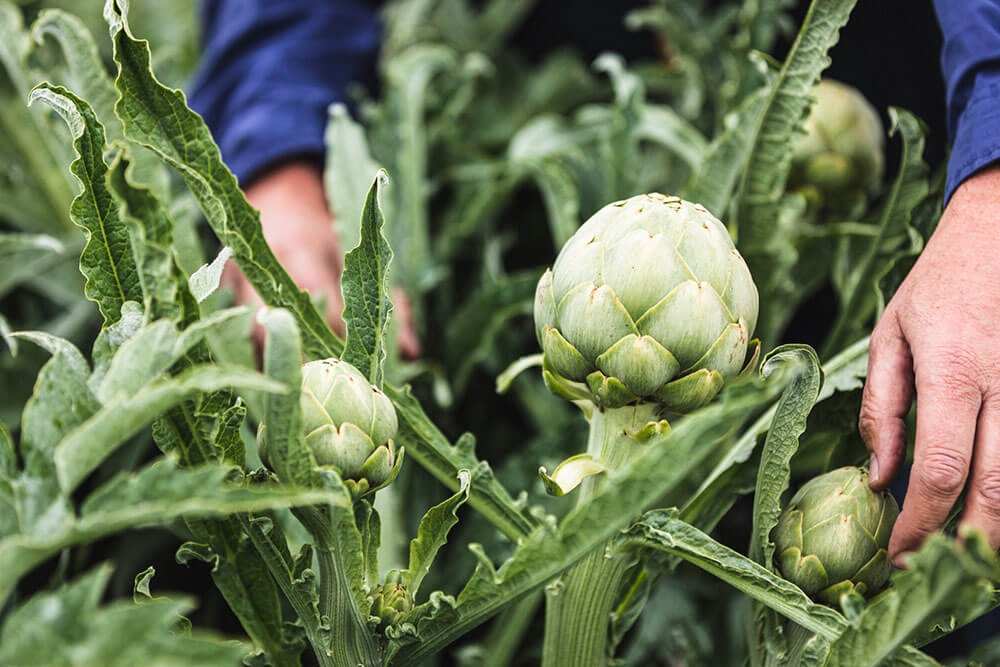
In the kitchen
How to store Globe artichoke
They are best eaten straight after picking, but they’ll keep well in the fridge for up to a week. A good specimen has a tight leaf formation and feels heavy for its size.
Prep & Cooking tips
Majestic and structural in the field; theatrical in the cooking and eating. Their unusual, nutty, asparagusy taste is one that’s well worth acquiring.
For boiling whole you simply need to trim away most of the stalk and cut off the top quarter of the head. Peeling the artichoke down to its heart is more involved; it is well armoured and much cutting, trimming and scrapping is need to claim the prized flesh.
They’re simplest boiled for 20-30 mins and eaten leaf by leaf, dipped in melted butter or vinaigrette. Suck the flesh base off the leaves. When you reach the central, feathery choke, remove it with a teaspoon and discard. If you choose to trim them down to their tender hearts, you can gently braise them in a little olive oil and white wine.
Easy ideas
1. Whole
The easiest way to deal with an artichoke is to boil it whole. To prepare it, cut off the top quarter, use scissors to trim off the tips of any visible leaves, and snap off the stalks. An average artichoke will take 20-30 mins to boil. Pull away the leaves, one at a time, dipping them in warm butter, and scrape and suck the nugget of tender flesh from each leaf. When you reach the centre, remove the furry inedible choke with a teaspoon before eating the tender heart.
2. Stuffed
Prepare as for boiling, but remove the feathery core with a teaspoon before cooking. Fill with a stuffing, packing the cavity and pressing it into the gaps between the outside leaves. We’d recommend ricotta, egg, parmesan and herbs. Braise with a little wine and stock in a covered roasting tray for just shy of an hour. Uncover for the final 20 mins for a bit of colour.
3. Trimmed & braised
If you have patience and dexterity, artichokes can be trimmed down to just their prized, fleshy hearts. Before cooking, keep in water, acidulated with a squeeze of lemon juice, to stop them discolouring. Then braise in wine and stock, or boil until tender. To prepare them, pull away the outer leaves, breaking them off as near to the base as possible, until the lower half of the remaining leaves are a creamy colour and tender rather than green and hard. Cut off the top with a sharp knife, leaving the cream-coloured bottom section. Trim the stalk and base, cutting away the tough green outer layer and leaf stubs to reveal paler flesh beneath. Quarter the artichokes, scrape out the chokes, then pop them in acidulated water until you’re ready to cook.
Goes well with
Acidic flavours (Lemon, White wine, Vinegar)
Cured pork (Bacon, Chorizo, Prosciutto)
Dairy (Butter, Cheese, Cream)
Green summer veg (Broad beans, Green beans, Peas)
Herbs (Bay, Chervil, Chives, Mint, Parsley, Tarragon, Thyme)
Shellfish (Crab, Prawns)
Mushrooms and truffles
Anchovies
Garlic
Globe artichoke recipes
-

Roast new potatoes and artichokes with rosemary and lemon
Serves: 2 Total time: 55 min
-

Roast artichokes and new potatoes
Serves: 8 Total time: 1h 10 min
-

Stuffed artichokes
Serves: 4 Total time: 1h
-

Artichokes with white wine and thyme
Serves: 2 Total time: 40 min
-

Jerusalem artichokes and mushrooms in a bag with goat's cheese
Serves: 2 Total time: 1h 10 min
-

Jerusalem artichoke and bacon gratin
Serves: 2 Total time: 40 min
In the field
-

Meet the grower: Riverford on Wash Farm , Buckfastleigh, Devon
Riverford founder Guy Singh-Watson started the business at Wash Farm in South Devon in 1987, and we’ve been growing organic veg at Wash ever since.





